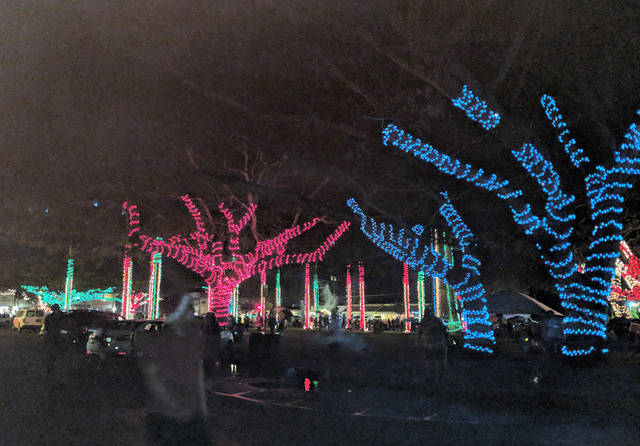The waves washed regularly on the strand below our picnic shelter, a pleasing background music to talk and laughter of a group gathered to “moon watch” on a recent evening. An intermittent breeze tugged at the beach naupaka leaves and flapped the palm fronds. Once twilight shifted to night, misty clouds sifted above like teasing veils over and around stars and planets, incoming planes and a passing satellite. Lady Moon Hina glowed regally, shining a moon path over the ocean waters.
On this Kauai beach evening, we eased back in our camp chairs, turning our eyes upward to enjoy sky watching. “Hey — there’s Cassiopeia.” “See — the Great Square (of Pegasus).” Kids and adults started commenting and questioning. “Where’s Orion’s belt?” “What’s that shape?” “Looks like Scorpio — see that hook-like tail?”
My husband filled in some of his star knowledge from past projects undertaken during his teaching days, pointing out Cepheus and commenting on the fact that we were using the ancient Greek names and established patterns, while there are Hawaiian ones now made accessible. “Uncle Dee” told the kids he was happy they liked sky watching, that he was going to go home and get his Hawaii Skies Astrorama project kit out of storage and bring it for them the next time.
Lo and behold, some minutes later a small form came up to him and held forth a smart phone lit with an overhead star pattern. I could see the smiles on this youngster’s face as he demonstrated how he could “point and shoot” at star after star to see a close-up view on the device’s screen, and also receive information via his app.
Meanwhile, “Uncle Dee” was starting to chuckle, a chuckle that erupted in true laughter — at himself. Here was a sign of the times (modern), showing how knowledge has evolved with the advent of smart phones and apps.
Sure, the Astrorama was fun to cut out of printer paper and paste on cardboard, cutting to shape and size, he commented to me. Writing in the various identification names also helps a student learn from the imprint writing makes. However, when this craftily made sky map is put to actual use at night, a flashlight is a necessity. A knowledge of cardinal points is also needed, and orientation of same at the watch site. Also, there’s a process of looking up and charting with the Astrorama in the dark, then checking the information in the flashlight’s beam, and so on — back and forth.
Here, with the sky map app, all is accomplished in a flash. Even our little primary school pal and his preschool brother could access info to absorb on their particular level of understanding. (Who knows? Budding astronomers in the making, circa 2035?)
We two are plain old skywatchers, not astronomers, but as such, present some upcoming events for others like us. Coming this Wednesday, just days — I mean nights — away, is one of the year’s three biggest meteor showers, the Geminids Meteor Shower. Under the best viewing conditions, peak rates can top 100. The Geminids will peak at 8:30 p.m. HST on Wednesday; however, activity is spread over at least a few days. Since moon rise takes place early (before dawn) starting Tuesday through Friday, these four morning will provide this year’s optimum viewing windows between midnight and moonrise, with Wednesday predicted to be best.
According to the International Meteor Organization Shower Calendar for 2017 and time and date lunar calendar, “Compared to all other showers visible from Hawaii, the Geminids have their radiant very high up in the sky, almost straight overhead. The meteors belonging to this shower are often bright and leave trails that can be visible for a few seconds. Watching … promises to be a rewarding event for all stargazers!”
Following on Dec. 21 comes winter solstice (10:28 HST), marking the shortest day and longest night of the Northern hemisphere. (This important calendric marking will be balanced by summer solstice around June 21, when we’ll experience the longest day of the year, and shortest night.) According to information provided through https:/www.timeanddate.com/astronomy/night/usa/honolulu, the Hawaiian term for winter solstice is “Ka mauikiikii o ka hooilo.” This website also provides and explanation of how the two solstices each year are derived through the sun’s relationship to “the celestial equator on the celestial sphere.”
A personal postscript is that “Uncle Dee” has reviewed his teacher’s archive with the patterns for the Hawaiian skies/names Astrorama, deeming it still good and useful. However, he recently made sure that we upgrade an LG flip phone for a smarter one — with sky watching app.
I have yet to desert my trusty Canon camera and shoot a photo on this very smart phone of the night sky. (Maybe, the Geminids, upcoming?) The first twinkling stars I’ve manage to capture are the sparkling lit-up trees on the lawn of the historic County Building when overcast skies and a light rain didn’t prevent the community’s involvement and enjoyment in marching or watching the “Lights on Rice” annual holiday parade. Dear Readers, it’s interesting — is it not? — how we humans bring the starry lights right down to us at this darkest time of the year. Happiest of winter solstices to all.
•••
Dawn Fraser Kawahara, author and poet, made her home on Kauai in the 1980s. She and her husband, a retired biology teacher, live with books, music and birds in Wailua Homesteads. They share the passion of nature and travel to faraway places. The writer’s books may be found in local outlets and on Amazon. For more information, go to tropicbirdpress@gmail.com.


